
scrounge: /skrounj/ informal verb: to actively seek [books] from any available source
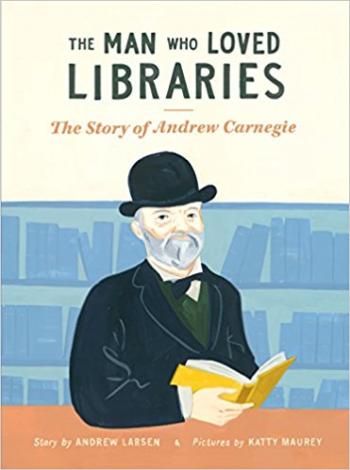
I really enjoyed this informative book about the life of Andrew Carnegie. I thought the pace of the story was well done -- it covered important information without getting bogged down in words, and the illustrations were nice too.
The narrative traces Carnegie's life from his poor beginnings in Scotland, to working his way up from factory worker to steel mogul in America, and then focuses on his charitable work building libraries all over the world.
At the end there were a couple pages of more detailed information, including the aside that Carnegie's relationship with his workers was "complicated," noting how he clashed with employees who were trying to unionize. Although this wasn't what the book was about, I appreciated this tidbit because it helped avoid putting Carnegie on too much of a pedestal -- though it was certainly inspiring to read about how he believed his riches were for giving away, and rather than just starting "charities," he truly wanted to empower people to help themselves.
(Thanks to NetGalley for the review copy.)
Scrounged From: NetGalley
Format: Kindle
Author: Andrew Larsen
Illustrator: Katty Maurey
Pages: 32
Content Advisory: None
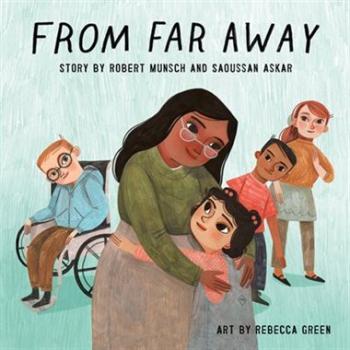
Global issues like the refugee crisis can be difficult to talk to children about, but even though it is based on events that took place twenty years ago, From Far Away expertly communicates the universal need to belong somewhere, from the perspective of a child.
Written in the first-person voice of young Saoussan Askar, this story briefly describes the danger of war in her native country (Lebanon, though I don't see this actually stated in the book), and Saoussan's struggles with integrating into the school in Canada, her new home.
She is scared by a skeleton decoration for a school play, and experiences other practical difficulties due to the language barrier. But as she learns English, Saoussan blossoms and begins to make friends and enjoy the activities in school.
The illustrations in this book are very expressive and do a great job of communicating Saoussan's various emotions as she makes the transition from one country to another. This book is a wonderful way to help children hear about some of the many obstacles faced by those who make the brave decision to flee violence, even after the violence is behind them.
(Thanks to NetGalley for a free copy in exchange for an honest review.)
Scrounged From: NetGalley
Format: Kindle
Authors: Robert Munsch and Saoussan Askar
Illustrator: Rebecca Green
Pages: 30
Content Advisory: The primary war description is on the first page when a bomb makes the family's roof fall in.
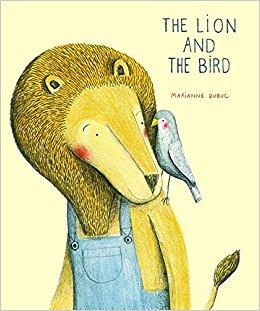
The Lion and the Bird is a beautiful, contemplative story by Montreal author/illustrator Marianne Dubuc, and it was originally published in French. It tells the story of a lion who finds an injured bird in the autumn, and cares for it over the winter. But when spring comes again, the lion understands that the bird has to fly away with the other birds.
One thing I love about the way this tale is told is that it makes space for sadness. Even though the book does leave us with a happy ending, we really feel the loss the lion feels as he walks sadly back to his house after saying goodbye. We watch him wordlessly trying to go about his daily tasks as usual, with the inescapable awareness that someone special is missing. "Sometimes life is like that," we are told.
Not only is there space for sad emotions, but Dubuc gives space for the tale to be told in the first place. At 64 pages, the book manages to feel complete and well-rounded without being "long." It is not overly wordy either -- the sentences are fairly short and simple, going back and forth between the narrator and words spoken by the lion.
The story itself could be summarized quite easily in a sentence or two, but the author makes use of white space, multiple frames, and also a few wordless pages to convey a linear narrative where even the small moments are important. This also gives space for the adult reader to point things out to a child, or ask questions ("How do you think the lion feels right now?") without disrupting the flow of the story.
This story is brief, yet thorough -- succinct, yet spacious, encompassing a look at each of the four seasons, the sadness of letting go, and the beauty of friendship.
Scrounged From: Our local library
Format: Hardcover
Author/Illustrator: Marianne Dubuc
Pages: 64
Content Advisory: None
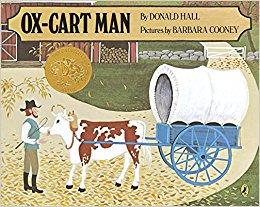
Ox-Cart Man is a book I grew up with, as did many others in my generation. Not only did it win the Caldecott Medal in 1980, but it was also featured on Reading Rainbow, a PBS show that helped so many of us to get or stay excited about reading.
It's the story of a year in the life of a farmer in the early 1800s, and describes all the things that he and his family grow, build, weave, and otherwise make, which the ox-cart man then takes to market to sell, one by one.
But rather than begin at the "beginning" of a year, the story drops us into the almost-end of the cycle, into the cool of an autumn countryside as the man loads up his ox-cart. After he sells everything, buys a few things, and walks the long way back home, we are briefly shown how all of his products came about in the first place, as the next cycle starts -- who made what, and when they did it. I suppose this goes to show that there really isn't a "beginning" -- farm life is an endless circle that works in seasons, and while one thing is ending, something else is beginning.
Once I obtained this book as an adult to read it to my kids, I began to wonder whether it would hold their attention. It just seemed so very practical and task-oriented. Not to mention there's a good deal of repetition in the middle when he's doing all the selling.
While it won't garner the excitement and laughter that many books seem to go for these days, and while it doesn't seem to be trying to be poignant, I still think it communicates something important in its way -- both as a reminder of the American past and a celebration (though subdued) of hard work, self-sufficiency, and family life.
Scrounged From: A present for our kids
Format: Paperback
Author: Donald Hall
Illustrator: Barbara Cooney
Pages: 40
Content Advisory: None
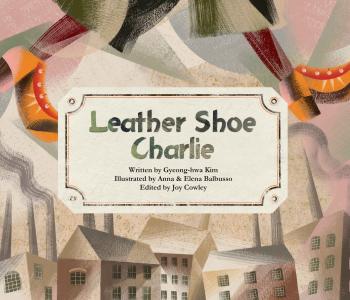
Leather Shoe Charlie is a beautifully illustrated introduction to the Industrial Revolution. Set in England, it tells the story of a family that migrates to the city of Manchester to find work.
This family includes a boy named Charlie, who proudly wears leather shoes that his cobbler grandfather made for him. The family's new home is dark and cramped, and they all have to work long hours (child labor is referenced but not elaborated on in the story). Despite their difficulties, Charlie's shoes help to remind him of his dream of becoming a cobbler himself one day.
But then his mother develops a persistent cough. Charlie hears that tea is good for a cough, but tea is far too expensive for his family to afford, and so Charlie gives the only item(s) of value that he has to try and help his mother get better. The story ends there, but emphasizes that the loss of his shoes did not cause Charlie to lose sight of his dream.
At the end of the book there are four pages about the Industrial Revolution including information about working and living conditions, key terms, a timeline, and some stats.
I really love the illustrations in this book -- I'm not very proficient at artistic terminology, but I suppose one could call them a bit abstract, with lots of "brushstroke" effects. This led me to the website of the Balbusso Twins, and wow! They have some amazing stuff. I also found out that this book was originally published in Korean.
Considering all the information it contains, this book is a great way to learn about an important facet of history in a way that puts a human face to it. It's also an important reminder that difficult circumstances do not stop children from having dreams.
Scrounged From: A LibraryThing giveaway
Format: Paperback
Author: Gyeong-hwa Kim
Illustrators: Anna Balbusso and Elena Balbusso
Pages: 36
Content Advisory: None


